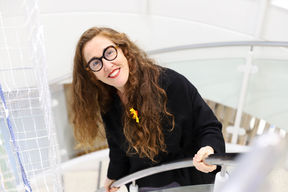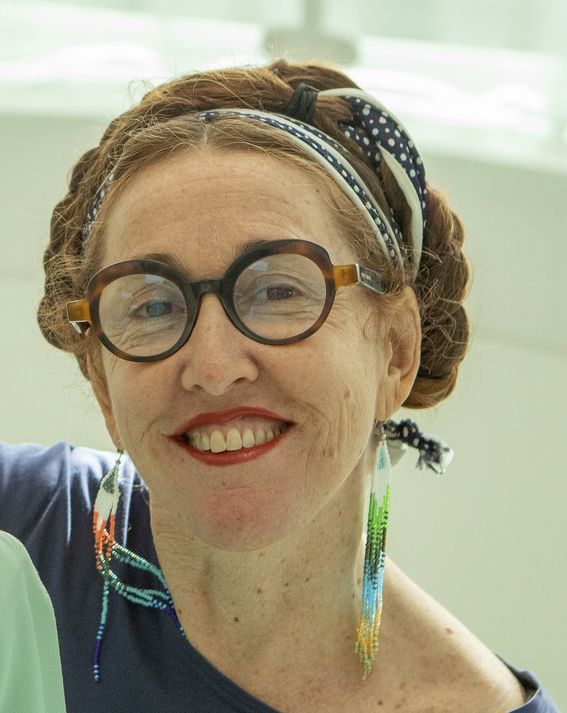Mariana Salgado is the Alumn of the Year of the School of Arts, Design and Architecture

Where do you work and what do you do?
‘For the past seven years I have worked researching and co-designing services and public policies around migration issues, first in the Finnish Immigration Service, Migri, and then in the Immigration department in the Ministry of the Interior. I was part of Inland design, an innovation and design lab that started in Migri and continued in the Ministry. The focus of my work has been in designing participation in projects related to immigration policies.
At the moment, I work as an independent consultant and public speaker on design via my own company. In addition, over the last five years, I have created and hosted a podcast called Diseño y Diaspora. This multilingual platform has become a substantial oral archive of design stories with a social design focus. With its 500th episode published just recently it is the largest podcast on social design in Spanish-speaking countries.’
Can you tell us more about your podcast?
‘The podcast was incorporated into the curriculum of over 30 universities and has 6 000 listeners a month. This has taken me around the world, especially to Spanish speaking countries. Besides this work in informal education, I teach in different organisations in Latin America. Last year I was invited to give keynotes in Cuba, Mexico, Argentina and Colombia in several universities.
Sometimes the topics might relate to my work as a designer, but I am also asked to talk on topics that are recurrent in my podcast. These topics range from feminist design, health, design-research, design education on to the collaboration of designers with indigenous communities. All this has widened my possibilities to listen and understand more of what is happening in the Global South.
As a designer and researcher my interest is on understanding the role of design in policy making but the podcast has allowed me to expand my interests and be able to research on other topics that I have not had the chance to work with.’
Mariana SalgadoI hope my work has the possibility to open doors to others in the field that are interested in the creation of public policies.”
What has been your career path?
‘I’m originally from Buenos Aires, Argentina, where I worked as a designer having my own company. I came to Finland 24 years ago to do my master’s studies in product and strategic design in the University of Art and Design Helsinki. Later, I did my doctoral and postdoctoral studies in the Media Lab at the Department of Media and received my doctoral degree 15 years ago. I’ve also worked in the University of Applied Sciences Laurea as a Head of the Master in Business Administration program in User Centered design and cofounded a design company.
Nowadays I lecture occasionally at Aalto University. Alongside my podcast several projects keep me busy all the time such as the publication of books coming from the content of the podcast. I have published three books up until now and I am working on a new one on design and health.’
What impact do you wish to have with your work?
‘One way to do work that aligns with my values and has an impact in society is to work in the public sector. I was lucky enough that I could do that. Ihope my work has the possibility to open doors to others in the field that are interested in the creation of public policies. Yet, not too many designers are involved in that, but more in the implementation. This is one of the areas in which service design is moving in Finland, and my work is part of that movement.
In every project, every policy creation there is a moment of listening to the stakeholders. First identifying them, and then understanding the main questions we need to answer together. As a designer my work is to ensure that participation happens in a consistent and coherent way. That we have the right people and organisations involved and that we address the right questions. This happens along the whole process of preparation of a public policy. That is what I call designing participation. It also forms part of making stronger democracies where the ones that will be impacted by a certain law, strategy or action plan, take part in the process of creating it.
The legitimization of design work in relation to policy creation will increase in the coming years and with it we wish to see more designers in the State Council. In other parts of the world designers are involved in policy creation, not only in the implementation of digital services. I am an optimistic, I think bringing design to policy creation will lead to a less hierarchical processes with an increased level of inclusivity to the ones that have been marginalised in our society. I believe design could bring social imagination as the solution to complex problems in the public sector.’
Mariana SalgadoI hope the Award is beneficial to give visibility to the great work designers are doing in the public sector in Finland.”
You are also active in networking with and for designers, can you tell us more about it?
‘I’ve co-founded a group for designers who work in public government in Finland, the network now consists of 500 people. There is a need for design in the public sector, and in Finland we value its contribution. There is a lot of potential in this network to change practices and lead innovation. The real impact will not come from my work, but through the work we do collaboratively, such as the work we do in networks and communities.

My podcast is another design community to which I contribute. I collect stories of decolonial design and work in the Global South through interviews. Designers in the Global South have a lot to tell us, and we should listen. Diseño y diaspora podcast activates others, while also offering a non-traditional platform and fresh perspectives in the current design context.
When magazines, newspapers, and exhibitions talk and showcase graphic, industrial, or fashion design, mainly related to commercial projects, I want to give a space for discussion for new forms of design such as service and strategic design. Also, designers who work in the public sector, the third sector, or who have set up cooperatives are interviewed.
Podcasting is a way to give access to knowledge, as all the content that I produce is published with creative common licences. A lot of research indicates that we need to find new ways to move and do less work in front of our computers. Listening to podcast is a way to be updated on what is going on in the field, while running, cleaning the house or repairing your socks. This also has an impact in our well-being.’
How do you see the future of service design?
‘In my opinion, service design and strategic design are more widely understood than before and this gives possibility to influence in new domains where we were not before. However, not all industries see this yet. In the future we will have more specialised designers working with life-centred approaches in new fields. In my opinion, it is essential to bring designers to policy creation, to the strategic level in organisations in the years to come. I envision designers working in transdisciplinary teams and together with others leading innovation processes.
I hope the future of design is feminist, decolonial and pluriversal and for this to happen we need more dialogue within design practitioners and researchers. Part of the work I do in my podcast is to amplify the voices of design researchers. Some listeners approached me to say that after listening to a podcast of an interview with a researcher, it is easier for them to read an academic article written by that person.
We need new channels for design research to reach not only those who can buy books but also those with fewer resources. The podcast gives value to orality and makes content accesible. It is also a way to think about a multilingual and multicultural future without frontiers.’
What does the Alumn of the Year Award mean to you?
‘I am surprised and honoured to receive this award. I'm incredibly grateful for my education at the University of Art and Design Helsinki and also at Aalto, because I did my postdoc here. It equipped me with reflective and critical skills that have been invaluable in navigating complex issues, such as immigration.
My studies in this institution have helped me understand the political implications of our design work and how every design decision carries a certain positioning and understanding of the context. In my work of designing participation within policymaking, it's crucial to consider who we invite to participate and how we take into account the impact of what we do in life, both in the short and long term.
I would like to interpret it as a recognition of doing work in spaces where designers have not entered before. I hope the Award is beneficial to give visibility to the great work designers are doing in the public sector in Finland.
This is also a recognition for my role as a design communicator. I play a role, as an educator devoted to informal education or life-long education. I think in the design ecosystem, there is a need to have designers doing this job. We need to bring out the voice of designers and our capabilities.
In a world where many trends come and go in the design industry, my education has provided me with the tools to navigate through them and to fearlessly explore new areas and formats of knowledge production. This could not have happened without the encouragement of being in a generous community of designers and researchers in Aalto. While working there, I enjoyed the exchange with my colleagues, the freedom of researchers and students and the peer learning. It has meant a lot to me.’
Read more news

DeployAI Partners Gather for Heart Beat Meeting in Helsinki
The European DeployAI project's partners gathered for the Heart Beat meeting hosted by Aalto University Executive Education in Helsinki.
Aalto computer scientists in ICML 2024
Computer scientists in ICML 2024
In low-hierarchy organisations, even key policy issues are discussed in Slack
In a recent study, Aalto University alumn Lauri Pietinalho, a visiting scholar at New York University's Stern School of Business, and Frank Martela, an assistant professor at Aalto University, investigated how low-hierarchy organisations deal with shared policies in confrontational situations and how authority functions within them.